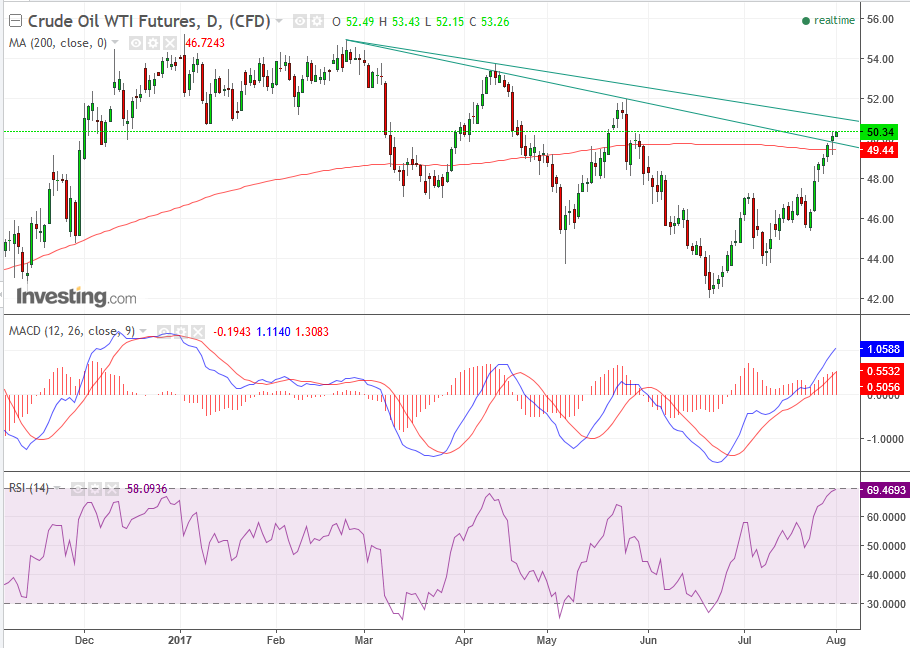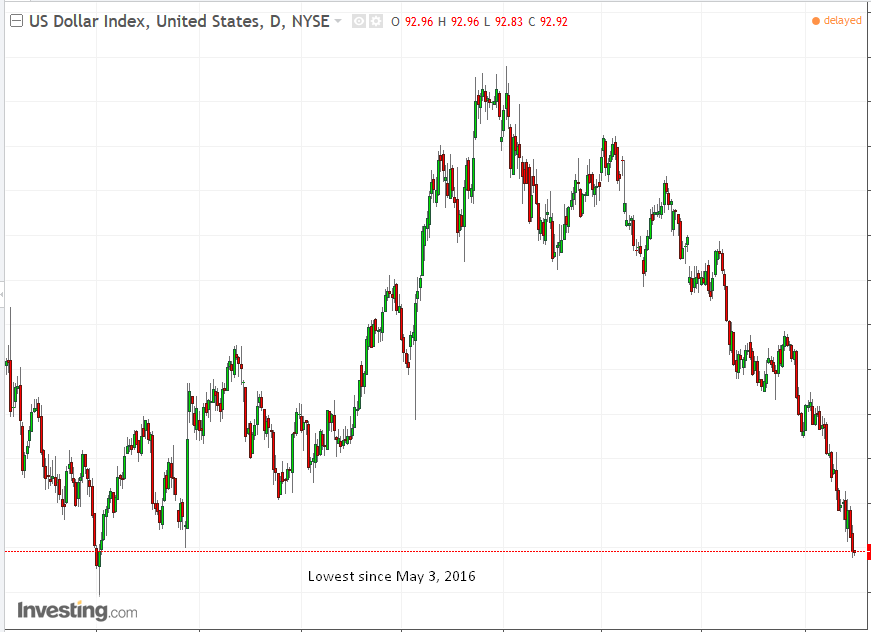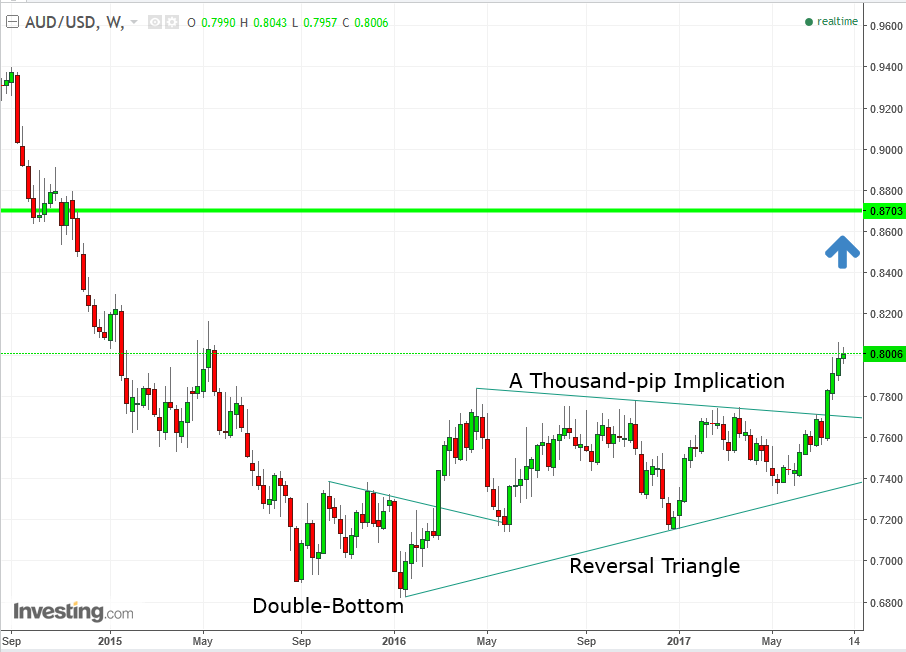by Pinchas Cohen
Global Affairs
Global economic growth is being confirmed on Japanese corporate results, Chinese manufacturing and South Korean export data which leaped 20 percent in July YoY and beat expectations. This across-the-board rise in economic results at the global market open continued yesterday’s rally, which was led by raw material producers after copper reached a two-year high. The MSCI Asia Pacific Index is at its highest levels since before the 2008 recession.
Chinese manufacturing, as measured by the Caixin Manufacturing PMI, rose again to 51.1 in July from 50.4 in June—its highest level in four months. These results confirm the expansion in Chinese manufacturing, which may offset the official government data showing renewed weakness in production and demand. Unlike in previous instances, when the divergence between official and private data created suspicion regarding the Chinese government numbers, currently the official read isn't better than the private version. This in turn has led investors to believe the government's numbers, at least for the time being.
European futures opened higher, suggesting that Asian markets are creating a global momentum.

WTI crude oil has reached $50 a barrel for the first time since May. The commodity is trading over the 200dma (red) for its third day, and has overcome the steeper uptrend line (which cuts through the intraday high of the April peak, and makes it more representative of the May apex), but is still below the purer uptrend line which respects all highs, at $51 per the current level . The ultimate resistance is expected from previous peak of $52.00, on May 25.
The MACD is the most overbought since January, before the decline, while the RSI is the most overbought since June 8 2016, making the current rally, from a momentum perspective, even more extreme than the one following the OPEC and NOPEC cuts. This makes sense considering the strongest rally of the year is happening after oil fell into a bear market.

The US dollar didn’t stand a chance after President Donald Trump fired White House communications director Anthony Scaramucci, only 10 days after hiring him. The dollar, having fallen its most in six year, is the big loser against all 16 major currencies. It was Trump who triggered its decline when he told the Wall Street Journal on January 17 that a strong dollar is “killing us.” While disappointing economic data hasn't helped since then, the never-ending, ongoing political drama generated by the current administration keeps pushing the dollar further down. Though Trump deliberately talked down the USD in January, the harm he's caused it since—whether he wants it to continue lower or not—has been a result of his not being in control of the situation.
In the final analysis, demand for a country’s currency reflects confidence in it by investors. The sad state of the dollar simply underscores the fact that the highest level of uncertainty among all the majors now resides with the US. After the Dollar Index reached its lowest level since May 3 2016, it made an attempt at a semblance of a climb but failed that as well, and was flat at yesterday’s close.
Down under, the Reserve Bank of Australia left interest rates at 1.5 percent per expectations. The bank warned that a strengthening currency, which advanced 11-percent this year, is expected to slow down inflation, growth and employment. It’s unclear to whom this warning was issued, as those who determine the price of the Aussie are speculators. Perhaps, the warning was in fact directed to them: don’t chew on more than you can bite; buy too many AUDs and you will end up with a weaker currency due to slower economic growth. But that seems farfetched.

The Aussie fluctuated after the non-decision, falling under $0.80, but rebounded as high as $0.8043. If the warning was aimed at speculators, they don’t seem concerned, for now. Technically, the AUDUSD bottomed at the end of 2015 and has been trading within a massive year-and-a-half-long triangle reversal, which was broken out of on July 13. It provides a thousand-pip upward target price.
Up Ahead
- 10:00: – US ISM Manufacturing PMI (July): The figure is expected to weaken to 52.3 from last month’s strong 57.8, which would be the lowest level since last October. Market to watch: US dollar crosses.
- BP (NYSE:BP) is expected to report earnings before market open. Consensus is calling for $0.14 EPS, vs $0.23 YoY, on $50.62 billion revenue.The stock has been trading in a range for a full year. Will results provide a breakout for shares above 38 or below 32?
- On Friday, the monthly nonfarm payrolls report is expected to show that employers added 180,000 workers during the month of July.
- Emerging-markets investors will turn their eye to Brazil on Wednesday, when its Congress votes on whether to put President Michel Temer on trial.
- On Thursday, the Bank of England will meet on interest rates. It's expected there will be no decision, leaving the key rate at a record 0.35 percent low.
Market Moves
Stocks
- The MSCI Asia Pacific Index rose to its highest since 2007 as global equity indexes advanced.
- Japan’s TOPIX added 0.6 percent. Banks rallied after Sumitomo Mitsui Financial (T:8316) reported a 31 percent increase in net income for the June quarter.
- Australia’s S&P/ASX 200 closed 0.9 percent higher.
- South Korea’s KOSPI climbed 0.8 percent.
- Hong Kong's Hang Seng rose 0.7 percent.
- China's Shanghai Composite climbed 0.3 percent.
- The MSCI All Country World Index gained 0.3 percent as of 8:58 a.m. in London, its highest on record on a closing basis.
- The Stoxx Europe 600 gained 0.3 percent.
- The U.K.’s FTSE 100 increased 0.8 percent, its largest climb in almost three weeks.
- Germany’s DAX climbed 0.2 percent.
Currencies
- The Dollar Index decreased than 0.03 percent to 92.92, after fluctuating.
- The yen added 0.1 percent to 110.16 per dollar, having climbed 1.9 percent in July.
- The Aussie rose 0.1 percent to 80.11 cents.
-
- The euro declined 0.2 percent to $1.1816.
- The British pound dipped 0.1 percent to $1.3206.
Bonds
- The yield on 10-year Treasuries gained one basis point to 2.30 percent.
- Germany’s 10-year yield decreased less than one basis point to 0.54 percent.
- Britain’s 10-year yield gained one basis point to 1.237 percent, its highest in a week.
Commodities
